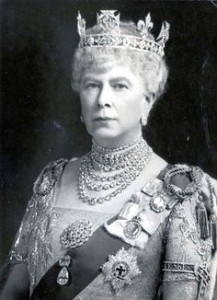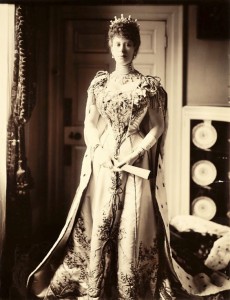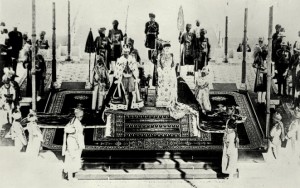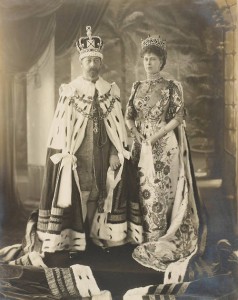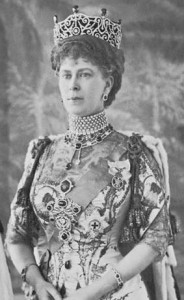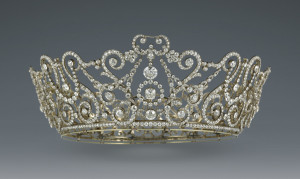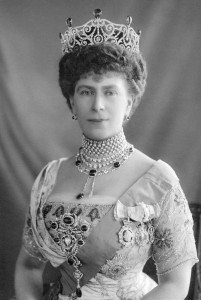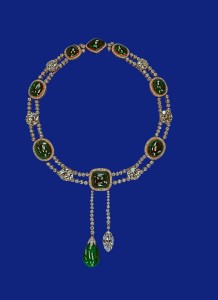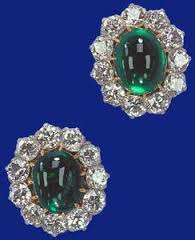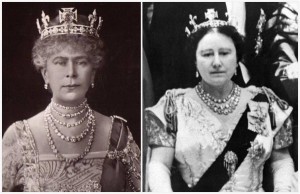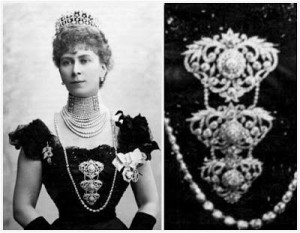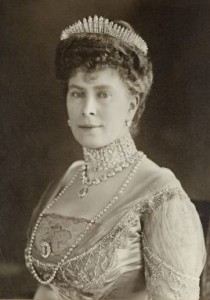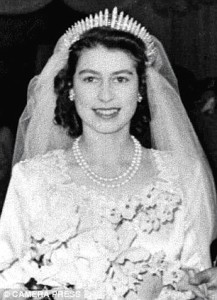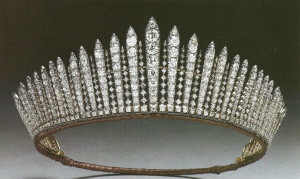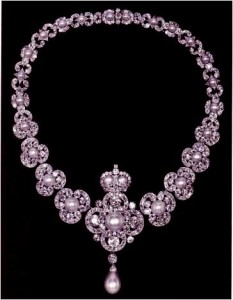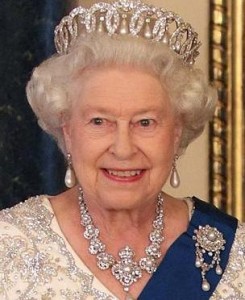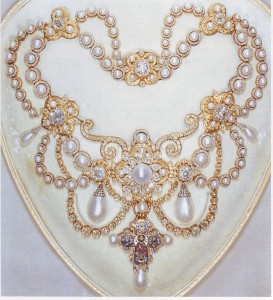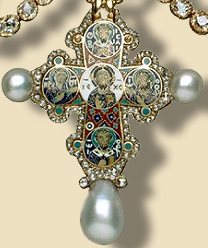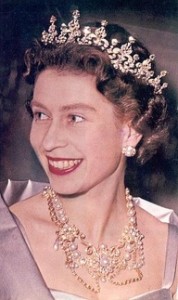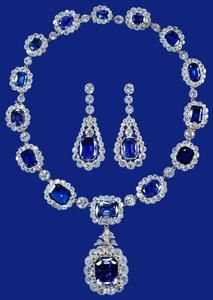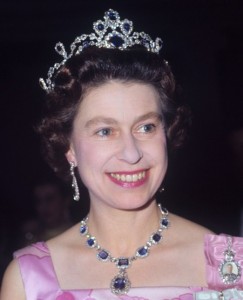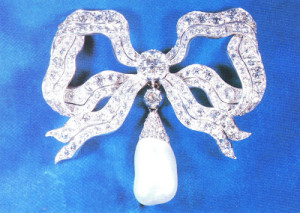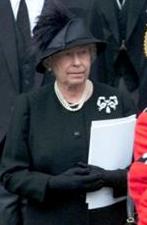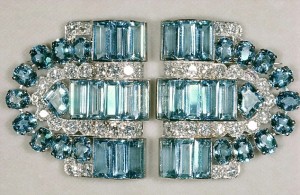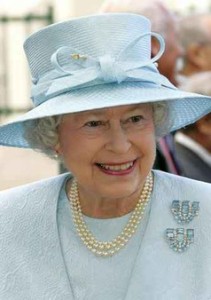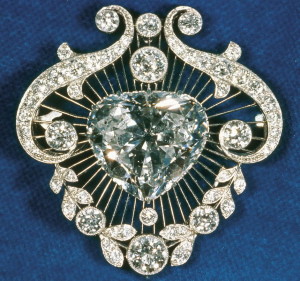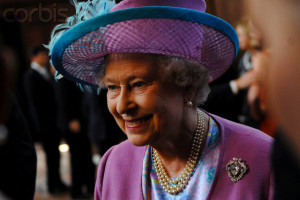In honor of Queen Mary’s birthday (born: May 26,1867 died: March 24,1953), in this post I will discuss her personal and extensive jewelry collection. Queen Mary was the consort of King George V and she was known for wearing several of these dazzling pieces of jewelry all at one time. She would wear several necklaces, brooche, stomachers, bracelets, rings and of course a crown, she often mixing diamonds, pearls, emeralds, sapphires and rubies. Perhaps this fashion style was excessive and it is possible that she had “inherited” it from her mother-in-law, Queen Alexandra, who was always lavishly jeweled and dressed at the expense of King Edward VII. (Queen Alexandra was a royal trendsetter influencing fashion and for more information on her, please click on the link to Queen Alexandra – A Fashion Icon)
Queen Mary wore items in her jewelry collection for special occasions such as her wedding, coronation and the Delhi Durbar. I will also single out a few of these noteworthy items such as the Love Trophy Collar, the Duchess of Teck Diamond Collet Necklace, the Karputhala Stomacher and finally the Fringe Tiara owned by Queen Mary.
So, let’s open up Queen Mary’s jewelry box …
Princess May of Teck (later to become Queen Mary) married Prince George (later to become King George V) on July 6, 1893 at the Chapel Royal in St. James Palace in London. In the photo below she is shown wearing a diamond tiara from Queen Victoria, a diamond rivière necklace which was a gift from her in-laws, Prince Albert Edward and Princess Alexandra. She also wears diamond earrings and an anchor brooch (which can be seen in the photo of the right) that were both wedding gifts from Prince George. Her elaborate bridal dress is heavily decorated with garlands of orange blossoms and Prince George wore the full dress naval uniform of a Fleet Captain which seems to be overloaded with medals and special honors. (For more information about the wedding of Prince George and Princess Mary, click on the click to British Royal Weddings – Part Two. Also for detailed information about Princess Mary’s bridal dress, please click on the link to British Royal Wedding Dresses – Part One)
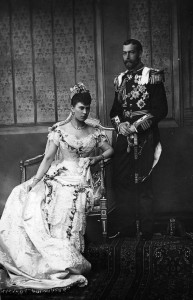
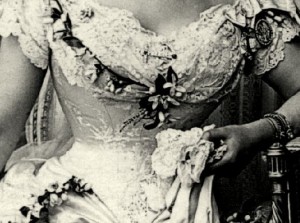
Upon the death of Queen Victoria in January 1901 her son, Prince Albert Edward, ascended to the British throne and his coronation took place on August 9, 1902 at Westminster Abbey in London. In the photo below Princess Mary is shown dressed for the coronation of her father-in-law, now known as King Edward VII. She is wearing the Girls of Great Britain and Ireland tiara, the Ladies of England tiara (converted into a necklace), a pearl and diamond choker, pearl and diamond earrings, a long sautoir and a few bracelets while on the gown’s bodice she wore a pearl and diamond stomacher, the Kensington bow brooch and the Women of Hampshire brooch. (For more detailed information on the Girls of Great Britain and Ireland tiara and the Kensington bow brooch, please click on the link to the Queen’s Jewelry collection – Part One)
After the death of his father, King Edward VII, in May 1910 Prince George ascended to the throne and his coronation took place on June 22, 1911 at Westminster Abbey in London. As his wife and consort, Princess Mary was also crowned in the solemn ceremony. Shown below in the photo on the left are King George and Queen Mary dressed in their coronation robes and crowns (King George was the first British monarch to be crowned with the St. Edward’s Crown, for more information click on the link to the Crown Jewels of England – Part One). Queen Mary’s Crown was specially made for the coronation by Garrard & Co. and featured 2,200 diamonds including the Cullinan III and Cullinan IV. The crown was constructed so that the eight arches and velvet lining could be removed to be worn as a circlet, as shown in the photo on the right which shows Queen Mary many years later in 1937 at the coronation of her son, King George VI.
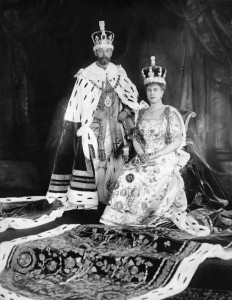
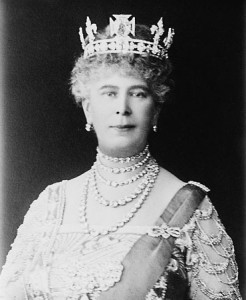
Upon King George V accession to the British throne, preparations were immediately begun for his coronation at Westminster Abbey in London and because he was also the Emperor of India a special celebration known as the Delhi Durbar was planned for December 1911. Historical Note: Previous Imperial Durbar had taken place in 1877 and 1903 but Queen Victoria and King Edward did not attend those celebrations and sent a royal representative instead. King George V was the only British sovereign to be present at the Imperial Durbar that crowned him as Emperor of India.
The Delhi Durbar was held from December 12, 1911 at the Coronation Park. Indian princes and other nobleman and other landed gentry from India attended the celebration. King George V and Queen Mary wearing their Coronation robes were crowned Emperor and Empress of India in an elaborate ceremony. Historical Note: The British government had determined that the valuable coronation regalia, including the St. Edward Crown which was part of the Crown Jewels, were not allowed to leave England. A new Imperial Crown of India was specially made for King-Emperor George to wear to the Delhi Durbar. (For more information about the Imperial Crown of India, please click on the link to the Crown Jewels of England – Part Two)
As she always did, Queen Mary was known to wear numerous pieces of jewelry at one time and the Delhi Durbar was no exception. She wore several necklaces, a set of earrings, stomachers, brooches and bracelets. Listed below are some of these items:
Delhi Durbar Tiara
Since the crown worn by Queen Mary at the 1911 Coronation was now considered part of the Crown Jewels it was not allowed to leave England. So, a new tiara was specially made by Garrard & Co. for her to wear at the Delhi Durbar and the tall circlet of platinum and gold featured diamond scrolls topped by ten cabochon Cambridge emeralds. Queen Mary in shown in the photo below wearing the Delhi Durbar Tiara.
In keeping with the royal custom of re-styling and re-purposing jewelry, in 1922 the Cambridge emeralds were permanently removed from the Delhi Durbar Tiara to be used in the Grand Duchess Vladimir Tiara. Then in 1923, the Delhi Durbar tiara was further altered so that two additional stones could be temporarily added to the Delhi Durbar Tiara, the stones were cut from the famous Cullinan diamond acquired by England in 1905. The Cullinan III, a 94.4 carat pear-shaped diamond, and the Cullinan IV, a square-cut 63.6 carat diamond, could be both placed into settings in the center front of the Delhi Durbar Tiara. Historical Note: The Delhi Durbar Tiara set with the Cullinan diamonds, as shown in the photo below on the left, was only worn by Queen Mary. Later the Cullinan III and IV diamonds were removed from the tiara permanently and reset to be worn together as brooch. In 1953, Queen Elizabeth II inherited them and the stones became known together as “Granny’s Chips”. Most recently Queen Elizabeth II wore the massive brooch for the Diamond Jubilee in 2012, as shown in the photo on the right.
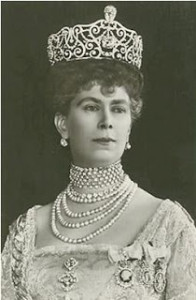
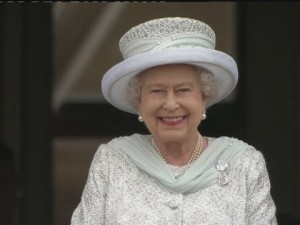
Over forty years later, Queen Mary lent the Delhi Durbar Tiara to her daughter-in-law (now known as Queen Elizabeth since the death of King George V in January 1936 and the ascension of her husband as King George VI), which she first wore on the 1947 South African Royal Tour. The Delhi Durbar Tiara remained in the possession of Queen Elizabeth, the Queen Mother until her death in 2002 when it was returned to the private collection of Queen Elizabeth II.
Delhi Durbar Necklace
The Delhi Durbar Necklace worn by Queen Mary in 1911 was made by Garrard & Co. at the request of King George V and presented to Queen Mary on the occasion of her 44th birthday, it was intended for her to wear the necklace at the Delhi Durbar. The necklace is set in platinum and gold with nine cabochon Cambridge emeralds, six large diamonds, 94 smaller diamonds and the Cullinan VII diamond which is an 8.8 carat marquise-shaped diamond. The Cullinan VII is suspended from a detachable platinum chain decorated with ten graduated sized diamonds. A second detachable platinum chain is also attached to the necklace to counterbalance the first chain and features 12 pavé-set diamonds. Queen Mary is shown in the photo below wearing the Delhi Durbar Necklace.
In keeping with Queen Mary’s custom of re-styling her jewelry, she would sometimes wear the Delhi Durbar Necklace without the asymmetrical pendant chains and on at least one occasion she replaced the Cullinan VII with a lesser stone. After Queen Mary’s death in 1953, Queen Elizabeth II inherited the necklace and she usually wears it for evening events paired with the Vladimir Tiara.
Delhi Durbar Earrings
The Delhi Durbar Earrings are part of the Delhi Durbar Parure created by Garrard & Co. and worn by Queen Mary in 1911. The earrings feature oval-shaped cabochon emeralds each surrounded by 11 diamonds which are set in platinum and gold. One emerald is from the famous Cambridge collection and the other was acquired by Garrard to match. In 1953, the Delhi Durbar Earrings were inherited by Queen Elizabeth II after the death of Queen Mary.
Typical of Queen Mary fashion style, she wore several pieces of jewelry at one time and shown in the photo below is the Delhi Durbar Stomacher with several additional brooches and pendants attached to create one massive piece of jewelry that Queen Mary wore on the bodice of her dress for the Delhi Durbar in 1911.
Arranged from the top to the bottom are:
Delhi Carved Emerald Brooch – given to Queen Mary by the ladies of India to wear at the Delhi Durbar. This brooch is set in platinum and gold and features a large hexagon shaped emerald is intricately carved with the images a rose on the front and an unidentified plant on the back and it is surrounded by several diamonds. In 1953, the Delhi Carved Emerald Brooch was passed to Queen Elizabeth and she only wears in occasionally due to its heavy weight.
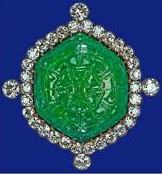 Delhi Durbar Stomacher – made by Garrard & Co. especially for Queen Mary for the Delhi Durbar. It is set in gold featuring several Cambridge emeralds and smaller diamonds, including some cut from the original massive Cullinan diamond originally acquired by England in 1905.
Delhi Durbar Stomacher – made by Garrard & Co. especially for Queen Mary for the Delhi Durbar. It is set in gold featuring several Cambridge emeralds and smaller diamonds, including some cut from the original massive Cullinan diamond originally acquired by England in 1905.
Cullinan V Heart Brooch – features the 18.8 carat heart-shaped Cullinan V diamond in a beautiful platinum setting with a pave border of smaller diamonds.
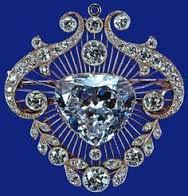 Scroll Cambridge Emerald Brooch – features a square-shaped emerald set in a scrolled diamond setting and a removable emerald pendant. Special Note: The removable emerald pendant was worn separately at the Delhi Durbar and can be seen in the first photo as the final piece.
Scroll Cambridge Emerald Brooch – features a square-shaped emerald set in a scrolled diamond setting and a removable emerald pendant. Special Note: The removable emerald pendant was worn separately at the Delhi Durbar and can be seen in the first photo as the final piece.
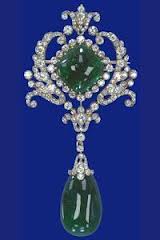
The next piece of jewelry associated with Queen Mary is the …
Duchess of Teck Diamond Collet Necklace
The Duchess of Teck Diamond Collet Necklace was inherited by Queen Mary from her mother, Princess Mary Adelaide. (She was the Duchess of Teck, hence the name of the necklace!) Queen Mary wore a longer version which had 46 large diamonds and it became one of her most frequently worn necklaces. Upon the death of Queen Mary, the Duchess of Teck Diamond Collet Necklace went to Queen Elizabeth, the Queen Mother who wore the necklace at the 1953 coronation of her daughter, Queen Elizabeth II. Upon the death of the Queen Mother in 2002, Queen Elizabeth II inherited the necklace and is today part of her personal jewelry collection.
In the photo on the left, Queen Mary is shown wearing the longer version of the Duchess of Teck Collet Necklace and in the photo on the right Queen Elizabeth, the Queen Mother is shown wearing the shorter version.
Love Trophy Collar Necklace
Before discussing the Love Trophy Collar Necklace worn by Queen Mary, let’s take a look back and see how this trend of collar necklaces started. Back in the Victorian era, Princess Alexandra (the future Queen Alexandra and mother-in-law of Princess Mary, the future Queen Mary) was also very creative in adapting her style of clothing to mask several physical impediments. She had a scar on her neck and she took to wearing day dresses with high collars and in the evening she wore multiple layers of pearls or diamond necklaces that would cover her neck, these were known as collier de chein meaning collar necklace. This style of jewelry became very popular with society ladies and a fashion trend was soon started.
So, as a young woman of the Victorian era and later the Edwardian era, Princess Mary followed the fashion trend and often wore collar necklaces. The Love Trophy Collar Necklace was made by Garrard & Co. in 1901 from diamonds of previous pieces of jewelry owned by Princess Mary’s grandmother and aunt. The diamonds are arranged vertically with panels linking them together, the center panel features a “love trophy” symbol (hence the name of the necklace) which has a design of a Cupid’s bow with a quiver of arrows surrounded by a laurel wreath. Queen Mary is shown in the photo the left wearing the Love Trophy Collar Necklace and the photo on the right shows the details of the necklace.
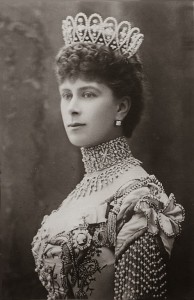
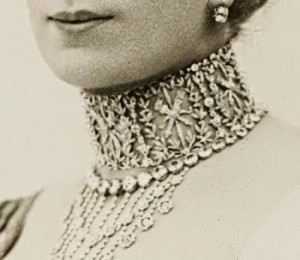
Soon after the Love Trophy Collar Necklace was made, the fashion of wearing collar necklaces soon fell out of fashion and Queen Mary passed the necklace to her daughter-in-law, Princess Elizabeth (the Duchess of York and later Queen Elizabeth, the Queen Mother) who rarely wore the necklace. Upon her death in 2002, Queen Elizabeth II inherited the necklace and she has never worn it in public.
Karputhala Stomacher
The Karputhala Stomacher was given to Princess Mary by the Maharajah of Karputhala as a wedding present in 1893. As previously mentioned, jewelry was often re-designed to extended the use of a piece. Shown in the photo below on the left is Queen Mary wearing the Karputhala Stomacher and the photo on the right shows the details of the three sections (which could be detached and worn as separate brooches) made of diamonds set in gold and white gold. Eventually the redesigned Karputhala stomacher was given by Queen Mary to her granddaughter, Princess Elizabeth (later Queen Elizabeth II) as a wedding present in 1947.
Queen Mary Fringe Tiara
The Queen Mary Fringe Tiara was made by Garrard & Co. in 1919 from the diamonds of a necklace previously given to her as a wedding present from Queen Victoria. The tiara had 47 bars of diamonds with smaller diamond spikes. In 1936, Queen Mary gave the tiara to her daughter-in-law Princess Elizabeth the Duchess of York (later Queen Elizabeth, the Queen Mother).
Then, in 1947 the Fringe Tiara was loaned to her daughter Princess Elizabeth for her wedding to Prince Phillip. On the wedding day the tiara broke but was quickly repaired by the court jeweler. In the photo below of Princess Elizabeth, the tiara can be seen looking a little off-center.
The Queen Mother also lent the tiara to her granddaughter, Princess Anne, to wear on her wedding day in 1973. The Queen Mother wore the tiara frequently over the years and when she died in 2002 the tiara was inherited by Queen Elizabeth II who also wears it often.
In past posts, I’ve discussed in detail the Crown Jewels of England, the Personal Jewelry Collection of Queen Elizabeth II and the Cambridge Emeralds. Other posts regarding famous pieces of jewelry included the Russian Imperial Jewels and the Jewelry Collection of Elizabeth Taylor. (For more information on any of these posts just click on the links)

